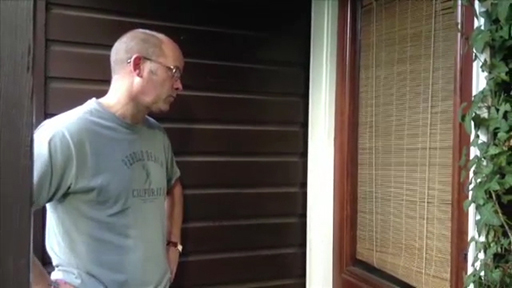4 Watch two approaches to a dispute
The following video example of a neighbour dispute draws out a number of ideas covered earlier in the course. The first part of the video (Clip 1) is an aggressive approach resulting in a full-blown argument between neighbours. Clip 2 shows a different approach results in far more of a dialogue between the neighbours.
Activity 3 Neighbour dispute and dialogue
- Watch the two clips. In Clip 1, swearing has been deleted but the overall aggressive tone of this dispute means you should watch it in private so as not to cause offence to others. Then watch the different approach in Clip 2.
- Focusing on Clip 2, identify examples of:
- phatic talk
- hedging language
- non-judgemental response (person-centredness)
- empathy (person-centredness)
- authenticity (person-centredness)
- active listening
- any other interesting observations of communication practices.

Transcript: Clip 1
[SCRAPING METAL]
[FOOTSTEPS]
[KNOCKING]
[DOOR OPENING]
[DOOR CLOSING]

Transcript: Clip 2
[METAL SCRAPING]
[FOOTSTEPS]
[KNOCKING]
[DOOR OPENING]
Discussion
This table is used to show some of the examples from Clip 2 that can be applied to each of the communication practices. In the table, Neighbour A is the visitor and Neighbour B is the home owner. Read about other interesting observations below this.
| Communication practice | Example from Clip 2 |
|---|---|
| Phatic talk | A: ‘Hello mate, how’s it going?’ |
| Hedging language | A: ‘I just wondered, whether at some point we could have a chat …’ |
| Non-judgemental | A responds in a non-judgemental way on hearing B has been ‘flat out’ |
| Empathy | A shows an empathy in expressing concern about what B and his children must be going through, his tone of voice also conveys this and it is also reinforced by asking ‘how are you feeling?’ |
| Authenticity | The manner in which B reveals his family’s struggles with his wife’s condition gives the impression that he is authentically showing part of his true self. |
| Active listening | A displays this throughout but in particular when he reflects back to B ‘I don’t want to add to your pressure but …’ and then about the tree removal timing ‘if it works for you it’s good for me’. |
Other interesting observations of communication practices are:
- The way in which A says ‘… the tree that is causing US a problem’, which makes it a joint problem.
- Neighbour A shows a degree of self-awareness and the impressions he might give others by remaining courteous, knocking on the door gently and keeping positive as the STPC model suggests.
- Assuming that this situation used actors, the only criticism might be that there seemed to be little use of minimal encouragers or hand gestures largely because their hands remained firmly stuck in their pockets through Clip 2.
While you have the Clip 1 footage from this confrontation in your mind, it is timely for you to briefly think about the challenges of using the telephone as the communication tool. Would it be a help or a hindrance in this dialogue?
